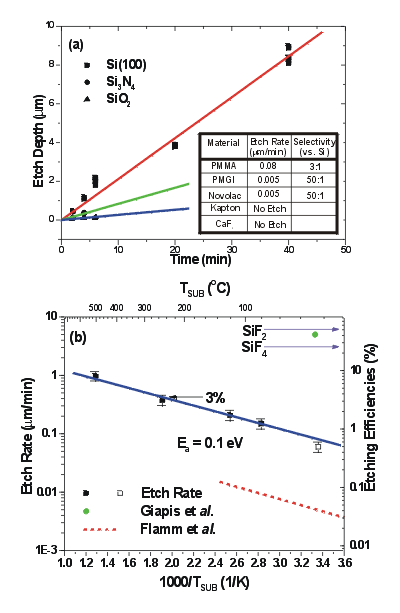 Fig. 2 Open Area Etch Results
(a) Etch depth vs. time for silicon, Si3N4 and SiO2 at TSUB=120° C.
Measured etch rates of resists at 200oC given in table (inset). (b) An Arrhenius plot showing silicon etch rate versus 1000/TSUB. Our results are shown with a solid line through solid squares. Room temperature etch rate is shown as an open square. The arrows indicate etch efficiencies for silicon assuming two (four) fluorine atoms for every silicon atom removed, i.e. SiF2 (SiF4). Results shown for Flamm et al.10 (dashed line) and Giapis et al.5 (solid circle) are normalized to our flux in order to compare etching efficiencies.
Fig. 2 Open Area Etch Results
(a) Etch depth vs. time for silicon, Si3N4 and SiO2 at TSUB=120° C.
Measured etch rates of resists at 200oC given in table (inset). (b) An Arrhenius plot showing silicon etch rate versus 1000/TSUB. Our results are shown with a solid line through solid squares. Room temperature etch rate is shown as an open square. The arrows indicate etch efficiencies for silicon assuming two (four) fluorine atoms for every silicon atom removed, i.e. SiF2 (SiF4). Results shown for Flamm et al.10 (dashed line) and Giapis et al.5 (solid circle) are normalized to our flux in order to compare etching efficiencies.
Figure 2(a) shows etch depths versus time for silicon and related materials at a substrate temperature (TSUB) of 120oC.
The spread in the data is due to run-to-run variations in the atomic flux arising from changes in the beam-source nozzle temperature and pressure. (Thermal dissociation of F2 is highly sensitive to both temperature and pressure.) Typical run-to-run etch-rate variations for the same nominal conditions are about 20%, while variations within the same run are lower. Measured etch rates for silicon, silicon nitride, and silicon dioxide for a substrate temperature of 120oC are 0.2, 0.08, and 0.03 mm/min, respectively. Typical photoresist materials etch at the rates shown in the table inset in Fig. 2(a), which also shows their etch selectivities compared to silicon.
Figure 2(b) shows an Arrhenius plot of the results of this work (solid line). For comparison, we also show results from Flamm et al.3 (dotted line) for atomic fluorine gas etching, and from Giapis et al.2 (solid circle) for atomic fluorine beam etching. All these results have been normalized to our flux. The slope of our line indicates a substrate-temperature activation energy of about 0.1 eV, in agreement with Flamm et al.3 The right axis of the Arrhenius plot indicates the efficiency of Si removal by fluorine. (The arrows at 50% and 25% indicate an etch rate assuming unit efficiency for producing SiF2 and SiF4, respectively.) Based on our atomic fluorine flux, our etching efficiency is 3% for TSUB=250oC, i.e., one Si atom is removed for every 30 incident fluorine atoms. This is much higher than the 0.25% efficiency determined by Flamm et al.3 (extrapolated to TSUB=250oC) for room-temperature atomic fluorine gas. Conversely, the results of Giapis et al.2 demonstrate much higher efficiencies for an energetic fluorine beam generated by pulsed laser-induced dissociation of SF6, even though this beam is incident upon a room-temperature substrate. It is clear that such large differences in etching efficiency are not due solely to the substrate temperature. We conclude that the etching rate is strongly dependent upon the incident kinetic energy of the atomic fluorine, which averages 0.025 eV for Flamm et al. (0.25% efficiency), 1 eV for the present work (3% efficiency), and 5 eV for Giapis et al. (40% efficiency).
 Fig. 2 Open Area Etch Results
(a) Etch depth vs. time for silicon, Si3N4 and SiO2 at TSUB=120° C.
Measured etch rates of resists at 200oC given in table (inset). (b) An Arrhenius plot showing silicon etch rate versus 1000/TSUB. Our results are shown with a solid line through solid squares. Room temperature etch rate is shown as an open square. The arrows indicate etch efficiencies for silicon assuming two (four) fluorine atoms for every silicon atom removed, i.e. SiF2 (SiF4). Results shown for Flamm et al.10 (dashed line) and Giapis et al.5 (solid circle) are normalized to our flux in order to compare etching efficiencies.
Fig. 2 Open Area Etch Results
(a) Etch depth vs. time for silicon, Si3N4 and SiO2 at TSUB=120° C.
Measured etch rates of resists at 200oC given in table (inset). (b) An Arrhenius plot showing silicon etch rate versus 1000/TSUB. Our results are shown with a solid line through solid squares. Room temperature etch rate is shown as an open square. The arrows indicate etch efficiencies for silicon assuming two (four) fluorine atoms for every silicon atom removed, i.e. SiF2 (SiF4). Results shown for Flamm et al.10 (dashed line) and Giapis et al.5 (solid circle) are normalized to our flux in order to compare etching efficiencies.